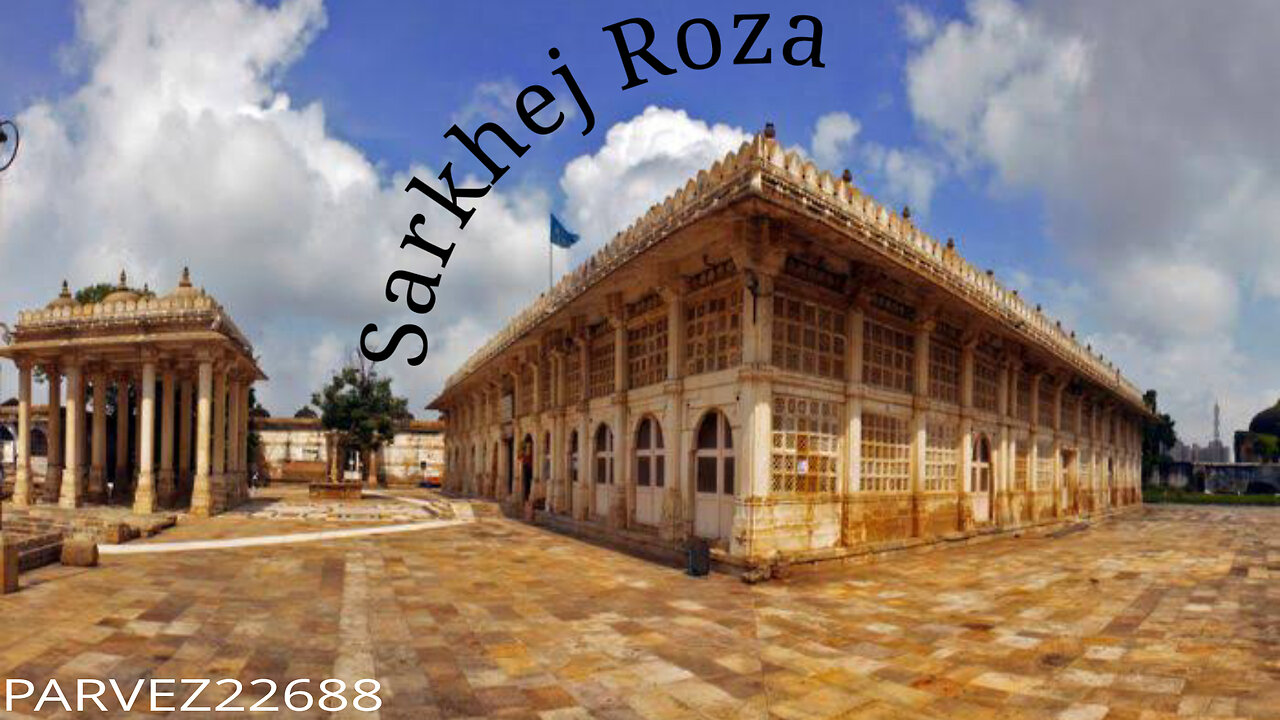Premium Only Content

The Sarkhej Roza, also known as the Sarkhej Tomb | Located in Ahmedabad Gujrat| India
Sarkhej Roza (Tomb )
Although there are many rozas[1] across Gujarat, the Sarkhej Roza is the most revered. Sarkhej was once a prominent centre of Sufi culture in the country, where influential Sufi saint Shaikh Ahmed Ganj Baksh lived. It was on the saint's suggestion that Sultan Ahmed Shah set up his capital on the banks of the Sabarmati, a few miles away from Sarkhej.
The architecture of the complex is credited to Azam and Muazzam Khan; two Persian brothers who are buried in the tomb near Vasna, Ahmedabad. The complex was originally spread over 72 acres, surrounded by elaborate gardens on all sides. Over time, human settlements came around it, eating into the gardens and reducing the area to 34 acres.
Shaikh Ahmed Khattu Ganj Bakhsh of Anhilwad Patan, the friend and adviser of Ahmad Shah I, retired to Sarkhej in his later life and died here in 1445. In his honour a tomb, begun in 1445 by Muhammad Shah II, was, in 1451, finished by his son Qutbuddin Ahmad Shah II. The next Sultan Mahmud Begada was fond of the place and expanded the complex greatly. He dug a large Sarkhej lake, surrounded it with cut stone steps, built on its south-west corner a splendid palace, and finally, opposite to the Ganj Baksh's tomb, raised a mausoleum for himself and his family, where he, his son Muzaffar Shah II, his great-grandson Mahmud Shah III and his queen Rajbai are buried.
Entering the covered eastern gateway on the north bank of the Sarkhej lake, the building to the right with a handsome stone pavilion in front of it, is the mausoleum of Shaikh Ahmed Khattu Ganj Bakhsh. This, the largest of its kind in Gujarat, has along its whole length its sides filled with stone trellis work, and inside, round the tomb, has a beautifully cut open metal screen. Across the courtyard on the left are two mausoleums with a connecting porch, the east mausoleum containing the tombs of Mahmud Begada, and of his son Saltan Muzaffar II, and the west, the tomb of Rajabai, Muzaffar's queen. Beyond the Ganj Bakhsh mausoleum is a courtyard, covering more than an acre of ground, surrounded by cloisters, with a mosque only slightly smaller than the Jama mosque. The want of minarets and the shallowness of its caves rather mar the outside effect. But inside 'it is the perfection of simple grace unrivaled in India except by the Moti mosque at Agra.' Looking across the lake the ruined buildings at the south-west corner are Mahmud Begada's palace and harem. The Sarkhej lake covers 17 acres. Oblong in shape, it is surrounded by flights of stone steps, and has a most richly decorated supply sluice.
Like many monuments built during that period, the Sarkhej Roza fused both non-Indian and Indian principles of architecture. While the ringed domes, the profusion of pillars and brackets can be claimed to follow the Islamic west Asian genre (even though they can also be found in Indian architecture itself since much before), much of the ornamentation and motifs have Indian Hindu designs. Most of the buildings do not have arches and depend on pierced stone trellises for stability. In its architecture, Sarkhej Roza is an example of the early Islamic architectural culture of the region, which fused Islamic stylistic influences from Persia with Indian Hindu and Jain features to form a composite Indo-Saracenic architectural style.[6] The mosque, with its courtyard, creates a religious milieu; the royal connection is made through the tombs and palaces; the great tank, platforms and pavilions were used by the common man.
The complex is called "Acropolis of Ahmedabad", due to 20th century architect Le Corbusier's comparison of this complex's design to the Acropolis of Athens.
-
 LIVE
LIVE
vivafrei
1 hour agoTrump Changing Tune on Operation Warp Speed? CBC Promoting Propaganda? Shiloh Hendrix Update & MORE!
1,262 watching -
 LIVE
LIVE
Dr Disrespect
3 hours ago🔴LIVE - DR DISRESPECT - TRIPLE THREAT CHALLENGE - WINNING AT EVERYTHING
14,377 watching -
 46:25
46:25
The Quartering
3 hours agoMeta PC Winner, Trump Ruins Libs Dark Fantasy & Raja Jackson Case Heats Up!
89.1K36 -
 LIVE
LIVE
Rallied
2 hours ago $1.15 earnedWarzone Challenges w/ Doc & Bob
407 watching -
 LIVE
LIVE
StoneMountain64
1 hour agoNew Missions for Battlefield 6 Unlocks (+New Mouse and Keyboard)
59 watching -
 2:09:47
2:09:47
Nerdrotic
6 hours ago $3.73 earnedHollywood's Long Dark Summer of the Soul - Nerdrotic Nooner 511
37.9K1 -
 1:36:05
1:36:05
Side Scrollers Podcast
3 hours agoStreamer ATTACKS Men Then Cries Victim + Pronoun Rant Anniversary + More | Side Scrollers
17K -
 12:06
12:06
Liberty Hangout
1 day agoDemocrat Woman Can't Define 'Woman'
33.2K68 -
 LIVE
LIVE
GritsGG
6 hours agoRumble Customs! 3515 Ws! 🫡!
344 watching -
 38:39
38:39
Grant Stinchfield
4 hours ago $1.39 earnedHow Local TV News LOST Its Soul
18.4K3